Vintage 2017: Most regions enjoy another good year for yields and quality
Mechanization spreads across North America as labor grows even more scarce
Wherever wine grapes ripened to maturity in North America in 2017, there were fewer human hands available to pick them. Growers and other experts in the wine industry say labor has grown even more scarce in the past year. That means more machines are picking grapes and being used for other vineyard jobs such as pruning.
“Getting enough harvest pickers still remains the No. 1 hurdle for vineyard operators. Finding enough pruning help would be the second most common hurdle. The use of more mechanical vineyard equipment will dramatically increase in the near future,” said Mike White, extension viticulture specialist at Iowa State University.
White was one of several advisors, academics, growers and winemakers who participated in Wines & Vines’ annual vintage report. Regional write-ups provided by experts throughout North America were complemented by a targeted survey of winemakers and the owners of vineyards and wineries in California, the Pacific Northwest, Midwest and eastern states.
In all of those regions, it was harder to find labor this year than in previous harvests. In the western states, the worry is the shortage will become even more acute as wine grape growers have to compete with cannabis farms. Many winery owners reported having to pay higher per-ton rates for hand labor or contracting with a company to provide workers.
California recorded a record deluge during the winter of 2016-17, with some parts of the North Coast seeing historic rainfall totals. All that rain was followed by fire later in the year, when wildfires raged through the North Bay in October. There were several major wildfires in the Northwest as well, but contamination from smoke appears to have been limited. In the Northern California counties of Napa, Sonoma, Mendocino and Solano, the majority of late-ripening grapes had already been picked. “This vintage was bookended by extreme weather events: a historically wet winter, and damaging October wildfires. In the winter, we were tuned to weather alerts of flooding, and in October road closures, evacuation orders, the uncertainty of property damage and the tragic loss of life,” reported Monica Cooper, the University of California farm advisor for Napa County.
According to the survey of California winemakers and growers, the bigger issue was heat waves in August and Labor Day weekend that damaged some clusters and also stalled grape ripening. Nearly 45% of those surveyed said harvest was “somewhat reduced,” and the heat was a primary reason.
In many parts of the Midwest, where wine grapes are grown alongside other crops, herbicide drift—particularly of dicamba—is a major concern. “Every year that wet field conditions delay row crop planting, drift becomes a major problem,” said Bruce Bordelon, a viticulture professor at Purdue University. “The record number of complaints filed by the state chemist this year indicate the problem is not being addressed through education alone.”
Despite the challenges, many growers, winemakers, university farm advisors and wine and viticulture professors reported in Wines & Vines’ annual vintage report that the wines of 2017 had excellent potential.
“The very warm September and first half of October pushed some exceptional fruit development and may produce some exemplary wines,” said Thomas Todaro, viticulture educator for the Michigan State University Extension.
Growers in Texas appear to have produced another record harvest of exceptional quality. “Overall fruit quality was very high throughout the state, and many winemakers expressed anticipation of an outstanding 2017 vintage,” said Ed Hellman, a professor of viticulture at Texas Tech University.
Wines & Vines appreciates getting harvest insights from around North America and would welcome input from any region not specifically covered in this report. Contact edit@winesandvines.com to help contribute to the 2018 report.
California
Fresno County
George Zhuang
Farm advisor
University of California Cooperative Extension
2017 was a very challenging year for southern San Joaquin Valley winegrowers. Bud break was generally normal for this area, but early bunch counts were lower than the historic average. Once the season started, some growers reported difficult powdery mildew control due to the weather that favored high disease pressure. Beginning in June, heat waves caused a significant amount of sunburn and heat damage to grapes. Specifically, vineyards experienced approximately one week of maximum daily temperature above 105° F in June and July, with another significant heat wave before Labor Day weekend.
After the onset of véraison, severe bunch rot issues were observed on several varieties including Zinfandel, Colombard, Thompson Seedless and even Rubired, which is rarely prone to rot. Bunch rot in many vineyards was quite significant, and vine mealybug was also a big issue for some growers. When the season moved close to the harvest, delayed ripening was reported on certain varieties such as Colombard, and poor color was seen on some red wine grape varieties such as Cabernet Sauvignon. Overall, yields were generally down across the southern San Joaquin Valley due to low bunch counts, powdery mildew, sunburn and bunch rot. However, the more recent plantings tended to outperform the older blocks in terms of production, and some new vineyards have much higher tonnage per acre.
Lake and Mendocino counties
Glenn McGourty
Farm advisor
University of California Cooperative Extension
This vintage from Mendocino and Lake counties was pretty good. The vines loved getting lots of rain. Yields were good but not exceptional. We experienced several weeks of very hot weather, but we were able to manage irrigation well and got to harvest with minimal sunburn. It worked out for most wineries, as grapes ripened over a long period, and they didn’t tie up tanks for too long.
Nice tasting fruit with a bit having low acid/high pH that needed fixing in the winery. Red fruit stalled a bit during ripening, and it took a while for sugars to go up. This should be a great vintage. We were mostly finished when the fires happened, and not many lots of fruit were affected. There were some vineyards that got singed.
Monterey, San Benito and Santa Cruz counties
Larry Bettiga
Viticulture farm advisor
University of California Cooperative Extension
Yields varied depending on variety and location, with most vineyards having average to below-average crops. The heat wave in early September had the most impact on Pinot Noir, causing berry dehydration. Exposed fruit in many sites had increased incidence of sunburn. After the heat wave, some vineyards were stressed by the high temperatures and had reduced maturation rates. These sites required additional time to achieve fruit-maturation goals.
Winter rainfall amount improved in 2017 to levels that were closer to annual averages. A mild spring resulted in bud break timing being closer to normal, ranging from late February to mid-March. A prolonged heat wave produced record temperatures during early September and caused the heat-related problems of dehydration and berry sunburn in some vineyards.
After the heat wave, dry and warm conditions stayed for the remainder of the harvest period. Harvest began in late August for sparkling wines and early September for still wines. The September heat wave accelerated the rate of harvest in early maturing varieties such as Pinot Noir.
As is typical of the cooler coastal areas, powdery mildew pressure is high. With adequate rainfall, strong shoot growth required additional canopy management to reduce canopy density and improve spray coverage. Compared to 2016, final powdery mildew incidence levels were much lower for the 2017 season. Due to the heat wave in early September and the lack of rainfall during harvest, Botrytis bunch rot levels were low. Mealybug populations remain a concern, as vineyards try to reduce mealybug populations to slow the spread of grape leafroll virus both within and between vineyards.
Grape demand is good with very little uncommitted fruit by harvest.
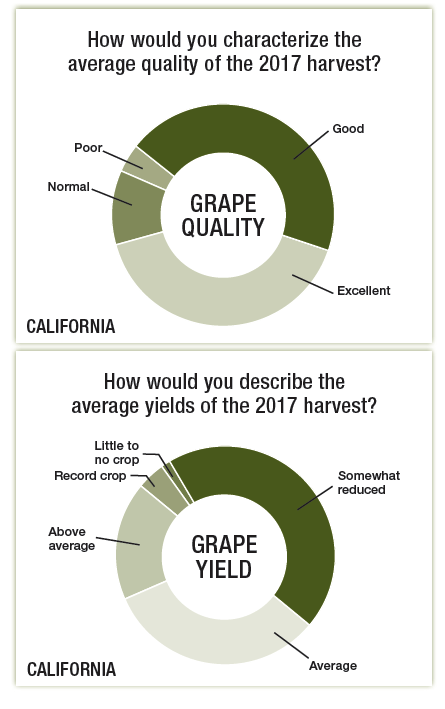
Napa County
Monica Cooper
Farm advisor
University of California Cooperative Extension
Vine growth was healthy following the wettest winter in 30 years and the third-wettest winter in 100 years. We experienced normal to cool conditions in the spring, aside from heat spikes in early May and mid-June, and a hail storm in June that caused isolated damage. An extended heat wave beginning near the end of August and extending into early September made for some hectic harvest conditions and was quite damaging to select cultivars. Cooler conditions following the heat wave decelerated the pace of harvest. It appeared we would be coasting to the end until the Diablo wind storm ignited damaging wildfires the night of Oct. 8.
This vintage was bookended by extreme weather events: a historically wet winter and damaging October wildfires. In the winter, we were tuned to weather alerts of flooding; in October, road closures, evacuation orders, the uncertainty of property damage and the tragic loss of life took priority.
Vine mealybug and olive fruit fly pest pressure was lower than in recent years, likely a result of wet, cool conditions in winter and spring, compared with warm, dry conditions during the drought. Visual symptoms (on leaves) of leafroll and red blotch diseases were muted and less obvious than expected. Pierce’s disease continues to be common, although at lower incidence than recent years.
.png)
San Joaquin County: Lodi, River Junction and Tracy Hills
Paul Verdegaal
Farm advisor
University of California Cooperative Extension
Yields were on the light side of average. Fruit quality was good, with total acids and pH levels good for the warm season. Harvest began about on average, then pace was moderate and mixed with mid-season varieties; late varieties slowed and finished on average. There was a worse-than-average amount of sour rot or summer bunch rot (see related story on page 122). A 0.2-inch rain in mid-October did not stall harvest as in the previous year. Some picking was delayed by winery scheduling. Harvest finished about on time compared to long-term averages (around Nov. 1 for most operations).
Winter of 2017 was the wettest in 20 years, about 180% of average rainfall. Vineyard flooding occurred along rivers and creeks, with many vineyards under some water until March; some blocks remained inundated until early June. Bud break was only three days early. Vine vigor was very strong from heavy rains and a warm, mild spring. Spring was warm and very dry. Days were warm and nights about average; no morning dew was present most of the year, and windy days were common. For about 25 days, the daily high temperature hit 100° F (the average is 17 days). Most of these were during three scattered heat waves. Light rain Oct. 19 did not stall harvest. Growing degree-days numbered 4,052, slightly above average.
Powdery mildew pressure was widespread with some scattered but severe problems, especially in the Delta. Mites came on very late—some severe, but also scattered. Vine mealybug populations were late and light compared to the two previous years. Sour rot or summer bunch rot was more severe than average, especially in Zinfandel for red programs. Symptoms of trunk canker disease complexes were less evident this year, possibly with reduced stress on vines from good winter rains recharging soils. Concerns grow about increasing incidence of grape viruses including grapevine red blotch, leafroll viruses and fanleaf virus in district and statewide sources of vines.
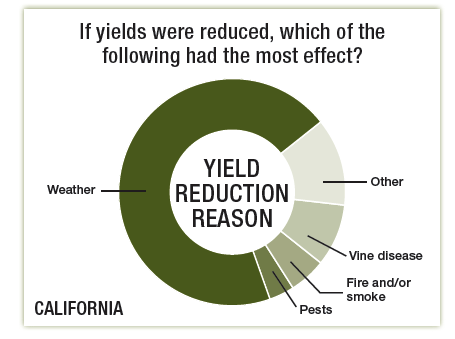 Prices were mostly static but softened for some varieties such as red Zinfandel and any blocks without a contract. Contract minimums were offered or very low offers for unsigned fruit from $250 to $350 per ton. Most other prices were stable: on average between $400 and $800 per ton, depending on variety. Muscat types, Chardonnay and especially Cabernet or any quality reds for blends were wanted. Almost all grapes were harvested, but a few blocks were left after late-October rains. There was new interest in Teroldego, Tempranillo and Petite Sirah; some Chenin Blanc and “newer” varieties such as Vermentino, Montepulciano, Nero d’Avola, etc.
Prices were mostly static but softened for some varieties such as red Zinfandel and any blocks without a contract. Contract minimums were offered or very low offers for unsigned fruit from $250 to $350 per ton. Most other prices were stable: on average between $400 and $800 per ton, depending on variety. Muscat types, Chardonnay and especially Cabernet or any quality reds for blends were wanted. Almost all grapes were harvested, but a few blocks were left after late-October rains. There was new interest in Teroldego, Tempranillo and Petite Sirah; some Chenin Blanc and “newer” varieties such as Vermentino, Montepulciano, Nero d’Avola, etc.
The year saw a dramatic increase in interest for high-wire cordon trellising systems for machine-pruned vines, new spray technology and evapotranspiration (ET)/soil-moisture monitors, surface renewal analysis for ET analysis and GPS mapping. Safety equipment and materials to meet new laws were also a focus. There was more need and demand for regulatory compliance consulting and/or “voluntary” sustainability programs.
Regulatory costs continued to soar; labor cost and availability were both major concerns. Fuel costs were one of the few inputs to decrease; most all other costs were up. There were new water coalition and heat stress rules, restrictions on pesticide use and establishment of local agencies for the Sustainable Ground Water Act introduced to growers.
Lodi was competitive for quality wines of value and receiving more recognition. More small wineries have been established. Some consolidation of grower operations continued. Growers were looking for good yields and/or lower costs at the same or better fruit quality. Growers replanted old/diseased vines, including some old-vine Zins. Some new vineyards were also planted. Interest in walnuts and almonds or other crops was abating. The Lodi Winegrape Commission and Lodi District Grape Growers were very active in education and regulatory sectors to keep growers aware and informed, along with providing needed input to policymakers and implementers.
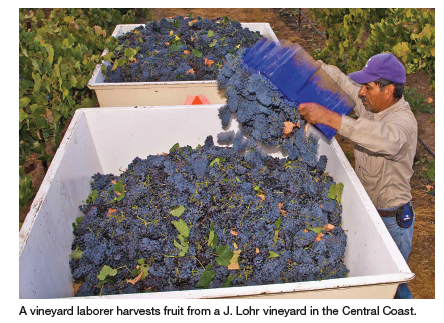 San Luis Obispo County
San Luis Obispo County
Jason Haas
Partner and general manager, Tablas Creek Vineyard winery
Chairman, Paso Robles Wine Country Alliance
Harvest 2017 was, for Rhone-variety producers at least, both plentiful and concentrated in Paso Robles. The good rainfall the previous winter meant that our cane length and canopies were significantly higher than recent years, and this combination allowed the vines to ripen even the generous crop sizes (up 20% vs. 2016) in good time and with plenty of intensity
Overall, it was a warm vintage. Bud break was not as early as in recent years, thanks to the cooler soil temperatures from the ample winter rainfall. The first half of summer was moderate, with a cool May extending into the first half of June. After mid-June, it varied between warm and hot, with a major heat spike in early July. It cooled off in early August before another major heat spike (nine days above 102° F) in late August and early September, which dominated the beginning of harvest and meant the early ripening grapes had to come off the vine in a hurry. Temperatures moderated the rest of harvest, and we finished a touch early, in late October.
Disease and pest pressure were modest this year, although the massive canopies made mildew somewhat more of an issue than it usually is here in Paso Robles—nothing too bad, though.
High yields among Rhône varieties meant lots of people were looking for homes for extra grapes at harvest time. If we had wanted more fruit, we could have found it at a good price.
Our Biodynamic flock of sheep, alpacas and donkeys did a great job of keeping the cover crops down and the vineyard well fertilized this year. The vines were exceptionally healthy, until they got zapped by the late-August heat spike.
Everyone was worried about labor shortages, and we had some difficulty finding supplemental crew during the heat spikes, but we made things work and got the fruit off in good shape. Tank space was at a premium because of the size of the harvest.
Sierra Nevada Foothills
El Dorado, Amador and Calaveras counties Sierra Foothills, Fair Play and California Shenandoah Valley
Lynn Wunderlich
Farm advisor
University of California
Cooperative Extension
Higher tonnages and mixed quality, mainly due to irregular weather patterns, characterize the 2017 Sierra Foothills vintage. Early whites and later harvested red Rhône and Italian varieties produced well with bright flavors in blocks that had the irrigation water to support larger canopies. Some Zinfandel quality suffered due to heat-induced dehydration of berries.
Powdery mildew was a spotty issue mostly cleaned up by the summer heat. Canker disease and esca was noticeably prevalent; red blotch was a major concern.
Zinfandel demand and prices were low; some Zinfandel vineyards are being grafted over to Italian and other more favorable varieties.
There is increased interest in mechanical harvesting due to chronic labor shortage problems. At least two harvest machines were purchased for use in the Foothills this past season, something that was unthinkable in previous years. Winemakers were debating if quality will be affected.
Sonoma County
Rhonda J. Smith
Viticulture farm advisor
University of California
Cooperative Extension
Yields were less than expected and, overall, at or just below average. Waves of hot, dry weather occurred each month beginning in June and continuing in September. There was a rush to get fruit in as maturity allowed in early September, when temperatures in warmer regions rose to more than 100° F, and relative humidity was under 10%. Those conditions caused fruit to dehydrate and some blocks to lose significant crop weight.
Santa Rosa rain-year precipitation broke the record in April at 57.8 inches. Wet weather in combination with a lack of field laborers prevented powdery mildew fungicide applications from hitting the target. As a result, by the middle of May, a large percentage of clusters in many blocks were diseased. Wet soils delayed the first fungicide applications, and abundant canopy growth kept the clusters from being adequately exposed because vines could not be shoot thinned soon enough. The incidence of botrytis shoot blight and esca were higher this year than normal. Vine mealybug infestations were discovered in more vineyard blocks and in vine shipments.
Grape prices continued to rise while growers were attempting to reduce costs while maintaining quality. More were incentivized to mechanically harvest and consider mechanizing other labor-intensive practices.
Labor costs were increasing at a faster rate than previous years as fewer people were working in vineyards. It is not known how commercial cannabis production beginning in 2018 will affect labor availability.
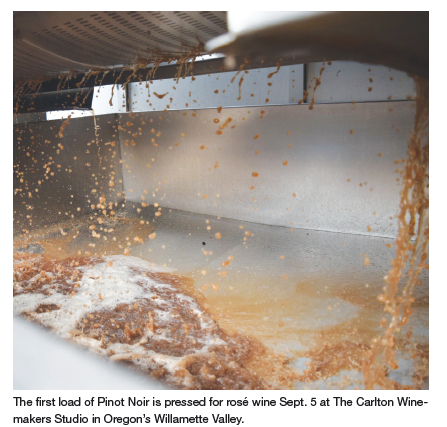
NORTHWEST
British Columbia
Peter Mitham
Northwest correspondent
Wines & Vines
Growers were generally reporting a good level of quality among grapes harvested, although winter damage, some disease pressure and heat during the growing season worked to cut yields for some varieties in some regions. Okanagan growers saw smaller berries in 2017 because of dry weather during the season, but these promised more intense fruit that will yield wines of like character.
British Columbia experienced a late spring, with many growing regions seeing above-average water levels into June. This encouraged vegetative growth. By late June, temperatures rose and the rain disappeared. Growing season temperatures were generally 15% above the long-term average but, following a cool spring, this was just enough to ensure fruit was ready to pick by the fourth week of August. September brought cooler temperatures, allowing a smooth finish to the season. Arctic in-flows brought the season to abrupt end Oct. 30 and allowed a harvest of grapes for ice wine Nov. 6.
Pest pressure in most growing regions of British Columbia was minimal. Cool, damp conditions combined with a blast of high temperatures in May raised the risk of mildew at bloom, requiring growers to be on top of spray schedules.
While the final tally is not due until early 2018, preliminary expectations were for a smaller crop, possibly less than 28,000 tons, making it the smallest in at least four years. This should support pricing for both grapes and bulk wine, especially red varietals.
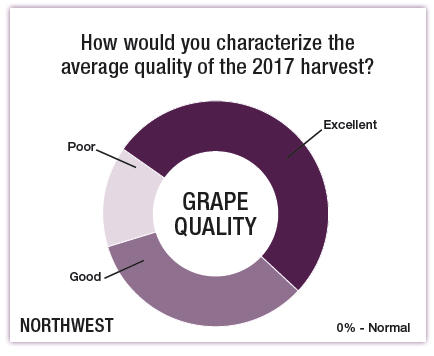
Idaho: Snake River AVA, Lewis Clark AVA and Central Idaho
Ashlee Struble
Office manager
Idaho Wine Commission
Some vineyards saw a greatly reduced harvest due to the severe cold last winter. A few of the high spots had more fruit but, by and large, southern Idaho saw a severely reduced production of wine grapes. After the cold winter, weather was cooperative: no disease pressure, and harvest finished a few days ahead of the average date.
In the Lewis-Clark Valley AVA, growers had a long, cold harvest, and the wet fall pushed harvest days back. Fruit flavors and colors were concentrated, but sugars were on the lower side. Central Idaho reported it lost production due to winter kill.
The Snake River AVA reported across the board a growing season that was gorgeous, with no spring frost and very low mildew pressure. The sunshine helped the vines to recover, and the fall was cooler, with hopes to have the vines go dormant and protect them from the deep chill of winter. A vineyard in the Lewis-Clark Valley AVA reported a challenging growing season with a lot of mildew pressure, minimal watering requirements and later harvest. In eastern Idaho, growers reported their growing season to be good, and the warm weather helped reestablish the vineyards in hopes for a much better year next year.
Vineyards in the Snake River AVA reported no disease pressure and very low mildew pressure, while vineyards in the Lewis-Clark Valley AVA reported a lot of mildew pressure. The Snake River AVA reported a mix of yields.
We continued to hear across the board that labor availability was a challenge for vineyards in Idaho.
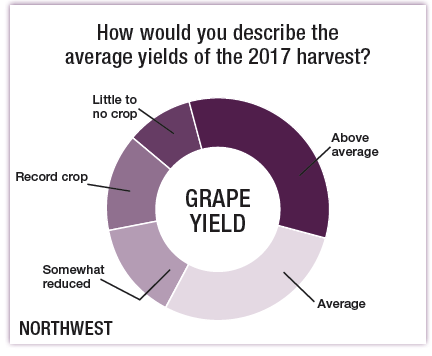
Oregon
Patty Skinkis
Associate professor and viticulture extension specialist
Oregon State University
The 2017 season was another high-yield year for Oregon. However, yields in most areas did not surpass those of 2015 (one of the highest yielding years on record). The industry is pleased with the quality of the 2017 vintage.
We had significant rainfall in winter 2016-17 that led to high soil moisture coming into the growing season. Warm temperatures in August helped vines catch up with fruit ripening. We had a more normal start to the growing season and more typical harvest dates.
With greater soil moisture, we had significant canopy growth in the first half of the growing season, which caused issues with powdery mildew in some regions of the state. Where canopy management was conducted timely, there was excellent control and no disease issues.
There were high yields in 2017, more mechanical harvesting than in prior years and fewer logistical issues for wineries with harvest being more spread out this year (almost one month).
Washington
Vicky Scharlau
Executive director
Washington Winegrowers Association
Smaller clusters in red grapes led to a light crop, which continued to shrink due to thinning to meet specifications in nearly all major wine grape varieties. An earlier than normal frost in some areas challenged late harvest in one major growing region for Merlot and Cabernet. Good flavors at lower sugars was a theme that started with Sauvignon Blanc and carried through harvest.
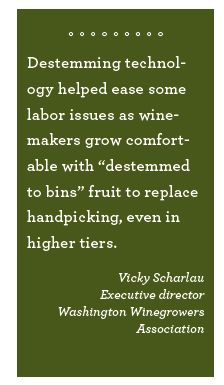 Some smoke events occurred but were not significant. A wetter than normal spring had a few early heat spikes, followed by a normal summer with a cool but stable finish in October. Other than the early frost mentioned, it was beautiful fall for finishing and harvesting grapes with very few rain days.
Some smoke events occurred but were not significant. A wetter than normal spring had a few early heat spikes, followed by a normal summer with a cool but stable finish in October. Other than the early frost mentioned, it was beautiful fall for finishing and harvesting grapes with very few rain days.
Some mildew pressure was due to weather: wetter than average spring, larger canopies and unsettled spring weather for spray applications. Mealybug pressure was higher than in recent years. Cases of leafroll were more widespread. Botrytis pressure was fairly low. Mites, leafhoppers and most other pests were managed in normal fashion.
After years of growth and strong demand for grapes, a general slowdown in the alcohol beverage marketplace (including slowed premium wine sales) slowed demand for grapes in Washington. Long-term contracts helped keep prices fairly stable, but demand for uncontracted grapes slowed except for special niche markets and club wines. A lower crop did not increase demand for uncontracted fruit, regardless of price per ton.
Growers used more mechanization in vineyards than ever before. More acres were 100% mechanized: pre-pruning, pruning, shoot thinning, leafing, wire movements, crop adjustments and harvesting. Thousands more acres were picked with destemming technology with probably a dozen new destemming harvesters in the state.
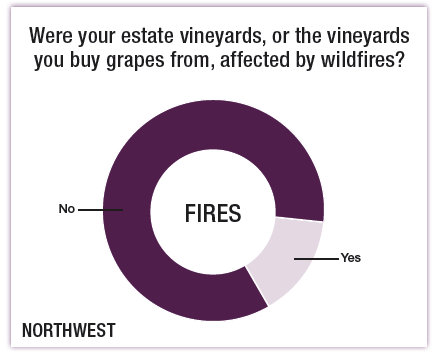
Labor was short. New trucking laws limiting driver hours impacted the harvest schedule and will increase costs in the future (winery pays for shipping but regulations will impact landed cost). A lighter crop made it easier to harvest with enough cooperage to finish on time. Destemming technology helped ease some labor issues as winemakers grow comfortable with “destemmed to bins” fruit to replace handpicking, even in higher tiers. The greatest logistical challenge with all the new production Cabernet Sauvignon was balancing the need to maximize hang time for ripening with the need to cover acreage with harvesters before the weather changes in late fall.
Central
Indiana: Ohio River Valley Indiana Uplands
Bruce Bordelon
Professor of viticulture
Purdue University
The 2017 vintage was excellent overall. Fruit quality was excellent for both early ripening white varieties as well as late-ripening reds. Quantities were reduced in some areas due to frost, poor fruit set and herbicide drift.
The Midwest experienced an early spring followed by a frost across much of the region in early May. Some vineyards suffered damage on early budding varieties. May was fairly wet, leading to delays in row crop planting and subsequent widespread herbicide drift issues. Some growers experienced severe losses, and the Indiana State Chemist Office fielded a record number of drift complaints. June was warmer than normal and drier. July and August brought cool, dry conditions that were ideal for ripening early white grapes. Quality was outstanding. Heat returned in September and October, just in time to help late-ripening reds reach full maturity.
Early season disease pressure was normal, but experienced growers had no problem managing black rot and phomopsis cane and leaf spot. Late season brought more downy and powdery mildew than usual, resulting in some post-harvest fungicide applications. Japanese beetles were the worst seen in several years. Ripe rot showed up near harvest on Marquette and Frontenac, varieties that are particularly susceptible. There were no reports of sour rot complex due to the dry conditions in late summer and fall. That was a welcome relief from normal.
Demand continued to be stronger than supply, leading to good prices for locally grown fruit. There is a need for more vineyard acres across much of the Midwest. Labor availability continues to be a concern for both winery and vineyard operations.
Herbicide drift was a major concern this year with the launch of new dicamba-tolerant soybeans and widespread use of dicamba during the growing season. Fortunately, few incidences of dicamba drift to grapes were observed during the season. However, drift from early season applications of growth regulator herbicides (dicamba and 2,4-D) continued to be a major concern for all specialty crop growers in the Midwest. Every year that wet field conditions delay row crop planting, drift becomes a major problem. The record number of complaints fielded by the state chemist this year indicated the problem is not being addressed through education alone.
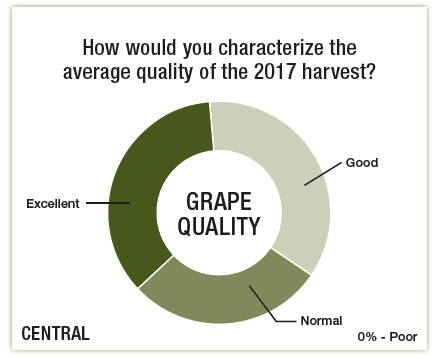
Iowa
Michael L. White
Viticulture specialist
Iowa State University Extension
The Iowa grape crop was of above-average quantity and quality this season. Much of the state experienced a moderate to severe drought that greatly reduced fungus disease pressure. The well-rooted grapes still produced a good yield under these drought conditions.
Approximately two-thirds of the state experienced a moderate tosevere drought. The drought combined with increased growing degree-days initiated the grape harvest the first week of August, approximately 10 days ahead of normal. Areas in the Northeast corner of Iowa received above-normal rainfall and some hail, causing higher disease pressure and lower yields.
The southwest two-thirds of the state had below-normal disease pressure due to low rainfall. The northeast corner of the state showed a high incidence of disease pressure to above-average rainfall.
Cold-climate grapes have been slowly trending upward. The range of prices for grapes delivered to the winery is $1,000 to $1,600 per ton, with the majority in the $1,200 to $1,400 per-ton range.
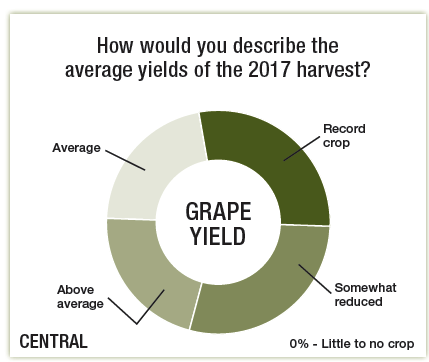 There are currently eight mechanical grape harvesters in Iowa. During the past two years, three of these harvesters were used to do some custom work for other vineyards. The 2015 Worker Protection Standard requiring pesticide safety training for pickers has created a situation where more mechanical harvesters will likely be operating in 2018.
There are currently eight mechanical grape harvesters in Iowa. During the past two years, three of these harvesters were used to do some custom work for other vineyards. The 2015 Worker Protection Standard requiring pesticide safety training for pickers has created a situation where more mechanical harvesters will likely be operating in 2018.
Getting enough pickers for harvest still remains the No. 1 hurdle for vineyard operators. Finding enough pruning help would be the second most-common hurdle. The use of more mechanical vineyard equipment will dramatically increase in the near future.
The Japanese beetle population was the highest Iowa has ever seen. The majority of vineyards in Iowa applied multiple insecticide applications for this pest during the summer.
Michigan: Leelanau Peninsula AVA, Old Mission Peninsula AVA and Tip of the Mitt AVA
Thomas Todaro
Viticulture extension specialist
Michigan State University Extension Agriculture and Agribusiness Institute
In general, early ripening varieties were harvested in late September through mid-October, and in some vineyards, late-ripening red and white varieties were still on the vine after fall frost occurred Nov. 9. As always, weather complicated vineyard operations. In spring 2017, northwest Michigan had conditions during bloom that were not conducive to a strong berry set. However, as grapes came into the cellar, many reported normal to above-average tonnage and quality. The very warm September and first half of October pushed some exceptional fruit development and may produce some exemplary wines.
This year had a significantly shorter growing season (fewer frost-free days) by roughly two to three weeks as well as earlier, colder minimum temperatures going into the winter than in 2016, resulting in a relatively short or non-existent post-harvest foliated period. In fact, some grape producers had clusters on leafless vines, which can have negative effects on the fruit and wood. Historically, grape producers overcome this problem with careful and hasty harvest and/or adjusting the intended use of the grapes to produce ice wine.
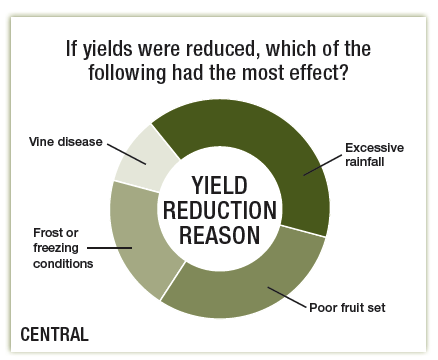 Disease and pest pressure was in the normal range, if not slightly below, as many grape producers reported they let their Pinot Noir and Pinot Gris clusters hang longer than usual because there was relatively low fruit rot incidence. One grape producer reported the presence of grape cane girdler Ampeloglypter ater (LeConte), which reduced the yield in that vineyard block by 33%. However, that was localized and not a widespread occurrence. Spotted wing drosophila (SWD) was monitored in vineyards, with large numbers trapped (1,400) in mid-summer in Leelanau and Old Mission. However, there have been no reports of catastrophic SWD damage to grapes.
Disease and pest pressure was in the normal range, if not slightly below, as many grape producers reported they let their Pinot Noir and Pinot Gris clusters hang longer than usual because there was relatively low fruit rot incidence. One grape producer reported the presence of grape cane girdler Ampeloglypter ater (LeConte), which reduced the yield in that vineyard block by 33%. However, that was localized and not a widespread occurrence. Spotted wing drosophila (SWD) was monitored in vineyards, with large numbers trapped (1,400) in mid-summer in Leelanau and Old Mission. However, there have been no reports of catastrophic SWD damage to grapes.
A recent economic impact study of Michigan wine grapes determined the average price per ton in the state is $1,340. Yields were within the normal range; some reported larger and heavier yields, while others reported lighter yields.
A flash detente system was unveiled at Black Star Farms. This is a thermovinification technology that uses heat and vacuum pressure to extract the most desirable colors and flavors while, in theory, reducing undesirable flavors in red grapes. This is important because the short and variable growing season of northwest Michigan has hindered the production of red wines with the color and flavor profiles desired by winemakers.
Labor shortage is a continuous logistical issue facing the grape producers of this region.
Riesling was reported to produce normal/high yield and fruit quality. Pinot Noir and Pinot Gris, Merlot and Cabernet Franc were reported to have relatively high yield and fruit quality, as they were allowed to hang on the vine longer than in past seasons. This increased time on the vine can improve flavor and color development important in red wine production in Michigan’s cool-climate viticulture.
Minnesota
Drew Horton
Enology specialist
University of Minnesota Grape Breeding & Enology Project
Minnesota is a vast area with many regions, but the following is based on our local area west of the Twin Cities and reports from around the state. The 2017 grape harvest in Minnesota was overall quite good, especially after the challenges of 2016, when the state received record amounts of summer rain that led to numerous problems including later ripening, dilution, widespread rachis necrosis and skin breakdown and splitting. In contrast to 2016, 2017 was notably better. In general, it was a vintage of lower pH levels, slightly lower Brix levels and slightly higher acidity levels, with reasonable and even improved yields throughout the state.
We did not experience any late-spring frosts (which can occur as late as mid-May). A moderate summer followed by an unusually cool August pushed back the beginning of harvest. We suspect this cool August was responsible for the low pH levels, with some varieties struggling to get above 3.05. Likewise, a lack of early fall frost events allowed most varieties to mature to full ripeness, albeit later than usual. Hail was an issue but effects were unequal and rather hit and miss. Some areas received hail in June during bloom and fruit set, which led to some reductions in yield; others received some September hail, which caused localized fruit damage.
Disease pressure was low, but insect pest pressure was high, with a widespread moderate to severe infestation of Japanese beetles within 30 or 40 miles of the Twin Cities (they have not yet spread statewide). In addition, the appearance of the spotted wing drosophila was noted but presented only moderate damage to certain early ripening varieties with softer and thinner skins.
Demand remained high as more and more new wineries come on-line, but prices were stable from 70 cents per pound ($1,400 per ton) to the highest in-demand varieties reaching to or slightly above $1 per pound ($2,000 per ton).
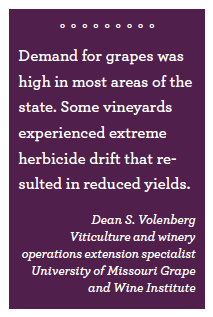 Missouri
Missouri
Dean S. Volenberg
Viticulture and winery operations extension specialist
University of Missouri
Grape and Wine Institute
Yields were at or below average, depending on location within the state. Fruit quality for whites, especially Vignoles, was excellent compared to the previous two years. Fruit quality for red varieties Norton and Chambourcin was excellent.
Weather conditions for harvest were excellent for most cultivars. The beginning of harvest in mid-August was on average dry for some early maturing white cultivars. This was followed by a very dry September that resulted in excellent harvest conditions. Monthly temperatures were above the 30-year average for most months during the April-through-October growing season. Most notable was the month of July, which had nine days above 90° F.
Disease pressure was greatest during the early growing season of April and May, when most parts of the state received above-average precipitation. Combined rainfall for the months of April and May was approximately 13 inches. Although early season vine growth encountered numerous precipitation events, disease outbreaks were minimal. Sour rot was noticeably absent in Vignoles this season, likely the result of dry conditions in the latter half of August and dry conditions in September. Pestalotiopsis spp. disease symptoms were apparent on leaves of Chambourcin and on Vignoles to a lesser extent during the month of May. Japanese beetle pressure was high starting in mid-June and lasting through late August.
Demand for grapes was high in most areas of the state. Some vineyards experienced extreme herbicide drift that resulted in reduced yields. Symptoms of herbicide drift from growth regulator herbicides was apparent in most vineyards in 2017.
In 2017, more than 132 acres of vineyards (or 8% of our total acres) were reported injured due to dicamba herbicide exposure or drift. With each acre of vineyard producing an average of 3-4 tons of grapes, the damage has a significant impact on the annual production levels.
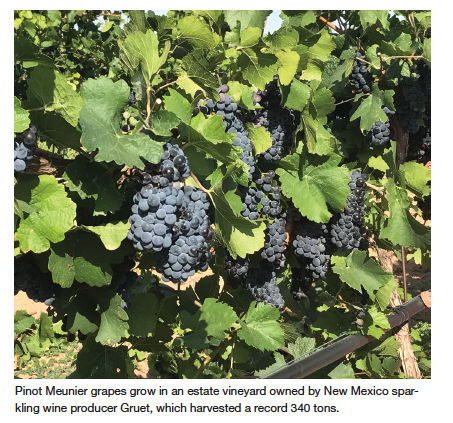 New Mexico
New Mexico
Gill Giese, Ph.D.
Extension viticulture specialist
New Mexico State University
Early harvested varieties in the northern growing regions yielded good to excellent crops with good acidity. Some vineyards experienced frost damage early, although they were able to harvest some secondary crop. Yields in the southern portion of the state were a bit smaller relative to 2016, although overall quality was good with some isolated incidence of bunch rot in minimally managed canopies.
February was unusually warm with relatively early bud break, followed by more than a week of 100° F days in June, shortly after berry set, and the slightly hotter temperatures persisted throughout the season. Some growers north of Albuquerque were hit with spring frosts and later by isolated hail storms. However, weather at harvest was, for the most part, unusually dry both north and south (July and August are considered “monsoon” season in New Mexico), making for ideal picking conditions. Rains continued late and hampered harvest in some late-ripening varieties, but it did not bring hail that is common in many years.
Overall, there was increased incidence of bunch rot and some powdery mildew exacerbated by higher than average precipitation, but insect pressure was not an issue.
Grape prices were unchanged or a bit lower than the previous year, with demand stable. Overall yields were down with a few exceptions.
Some growers used a new scale device to weigh grapes early in the harvest process in order to streamline tank space allocation logistics. Some growers installed and used weather stations to better inform harvest decisions and organize labor earlier to ensure adequate help.
There were no major issues getting pickers, as most picking occurred after August, when most of the demand for chili pickers was fading out. Many larger plantings increasingly utilized machine harvest. Although irrigation water was plentiful, it required constant treatment.
Spring frost caused some damage, especially with early budding varieties such as Chardonnay, although secondary crops were substantial. Nematodes continue to be a threat, causing reductions in vine health and yields.
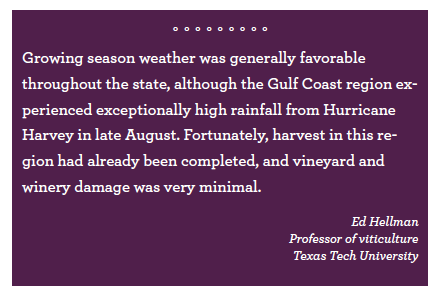 Texas: Texas High Plains AVA, Texas Hill Country AVA and Texoma AVA
Texas: Texas High Plains AVA, Texas Hill Country AVA and Texoma AVA
Ed Hellman
Professor of viticulture
Texas Tech University
The 2017 Texas wine grape harvest set a new record, although precise numbers are not yet available. Favorable weather and new vineyard acreage, especially on the Texas High Plains, combined to produce the record crop. All regions escaped spring frost damage, and good weather during bloom created large crop potential. A few vineyards on the Texas High Plains had yield reductions from a summer hail storm, and some vineyards experienced bunch rot following rain during harvest. But overall fruit quality was very high throughout the state, and many winemakers expressed anticipation of an outstanding 2017 vintage.
Exceptionally mild winter temperatures raised concerns for early bud break and increased risk of frost damage, but favorable weather continued through bud break and bloom. Growing season weather was generally favorable throughout the state, although the Gulf Coast region experienced exceptionally high rainfall from Hurricane Harvey in late August. Fortunately, harvest in this region had already been completed, and vineyard and winery damage was very minimal. Ripening conditions were very favorable in the Texas High Plains and the Texas Hill Country.
Fungal disease pressure was about average in 2017, and generally did not pose an exceptional threat to yield and quality anywhere in the state. Post-harvest disease pressure for downy mildew was very high in the Gulf Coast region due to heavy rains from the hurricane. Similarly, insect pests such as grape berry moth were at typical population levels in 2017 and were readily managed below the point of significant damage.
The record grape crop met or somewhat exceeded most wineries’ demand for fruit in 2017. Prices were mostly unchanged from the previous few years, but with more new acreage coming into production on the Texas High Plains, some downward pressure on grape prices could occur in 2018.
Increased planting on the Texas High Plains of cotton varieties resistant to dicamba or 2,4-D led to greater herbicide drift damage to vineyards in 2017 than any previous year. Some symptoms of herbicide drift injury were evident in nearly every vineyard on the Texas High Plains, and a few vineyards had severe injury with stunted shoot growth and reduced yields. Grape producers are concerned about potential multi-year impact on damaged vines and cumulative effects of herbicide exposure.
Record yields led to a shortage of tank space at a few wineries, although the timely opening of a new custom-crush facility helped absorb the large crop. Labor availability continues to be a challenge.
Many Rhône, Italian and a few Spanish varieties that continue to perform well in the vineyard and winery tended to dominate new plantings. Mourvedre stood out among red varieties in the Texas Hill Country and Texas High Plains. High-quality varietal Mourvedre wines (red and rosé) and Rhone-style blends were being produced. Viognier, Roussanne and Marsanne were performing very well on the Texas High Plains, where conditions for bunch rot were less common. Montepulciano and Aglianico also were performing very well in both the Hill Country and High Plains. Tempranillo has been extensively planted throughout the state.
East
New York
—Long Island
Alice Wise
Viticulture researcher
Cornell Cooperative Extension of Suffolk County
2017 was an unusual season on Long Island. While total growing degree-days were similar to 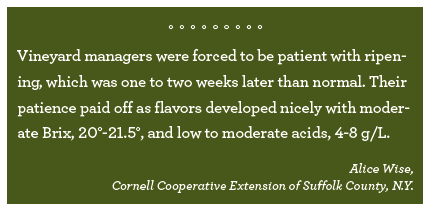 previous seasons (around 3,500), there were wide fluctuations in temperatures month to month. Slightly cooler than normal temperatures prevailed in spring and again in August and early September. This delayed grape phenology by one to two weeks compared to 2015 and 2016. October, on the other hand, was unusually warm. The bulk of harvest takes place in October, and it was odd to be harvesting fruit in warm weather. Rainfall was fairly consistent with 3-4 inches each month. There was a relatively short period of dry weather in summer instead of the usual four to six weeks of drought.
previous seasons (around 3,500), there were wide fluctuations in temperatures month to month. Slightly cooler than normal temperatures prevailed in spring and again in August and early September. This delayed grape phenology by one to two weeks compared to 2015 and 2016. October, on the other hand, was unusually warm. The bulk of harvest takes place in October, and it was odd to be harvesting fruit in warm weather. Rainfall was fairly consistent with 3-4 inches each month. There was a relatively short period of dry weather in summer instead of the usual four to six weeks of drought.
The labor outlook for Long Island’s diverse agricultural industries is similar to other regions. Some ag businesses including vineyards were short-handed throughout the season. For the wine industry, this has led to an increase in mechanization with a number of growers purchasing mechanical leafers. There has also been an increase in machine versus hand harvest.
Good canopy management and disease control were important in 2017. Downy mildew was an issue in some vineyards due to large vines, periodic rainfall and dewy mornings. Infections were mostly in the upper third of VSP canopies. Potato leafhopper infestations, though typically spotty, were more widespread. Grape berry moth infestations were minimal for a change.
Vineyard managers were forced to be patient with ripening, which was one to two weeks later than normal. Their patience paid off, as flavors developed nicely with moderate Brix (20°-21.5°) and low to moderate acids, 4-8 g/L. There was a touch of sour rot in early varieties such as Pinot Noir and Sauvignon Blanc, aggravated by swarming yellow jackets. Fortunately, they did not persist through the remainder of harvest. Botrytis infections ranged from negligible to moderate, variable by vineyard and variety. Bunch stem necrosis was common in older blocks of Cabernet Sauvignon, even in a few Merlot blocks. This is usually absent or a curiosity at best. Overall, the 2017 harvest had clean, bright, balanced fruit with subtle, nuanced flavors. We look forward to tasting the results of our labor.
New York
—Finger Lakes: Yates, Ontario, Wayne, Seneca, Schuyler and Steuben counties
Hans Walter-Peterson
Viticulture extension specialist
Cornell Cooperative Extension
The 2017 season represented a big departure from the conditions that the Finger Lakes experienced in 2016. That year’s record drought meant crop yields were lower (smaller berry size and some loss of crop), and a very warm season led to high Brix and lower acidity in fruit. In 2017, a larger than normal crop with cooler temperatures most of the season meant slower ripening, slightly lower Brix than normal and higher acidity, but the overall assessment is still positive about quality in 2017. Harvest was about one to two weeks later than normal in many cases, with lots of grapes harvested after Halloween.
The 2016-17 winter was kind to the region’s vineyards for the first time in several years, which meant very little crop and vine loss due to winter injury. Rains seemed relentless this spring and summer, leading to heavier disease pressure, lots of canopy growth and higher berry weights. Fortunately, the weather pattern changed in September and October, with warmer temperatures and drier skies predominating during much of harvest. Overall total rainfall in the 2017 growing season was twice as much as 2016, our driest season on record. That’s what we call vintage variation.
Because of higher than normal rainfall, disease management was more challenging. Downy mildew in particular presented difficulties for growers who were not conscientious about rotating materials, using proper rates and maintaining adequate spray intervals. Botrytis infections became established in the early summer due to the rains that persisted at that point, but drier weather and good management practices prior to and during harvest helped to keep those infections from having a major impact on fruit quality in the end.
The combination of sunny conditions during bud development in 2016 (leading to higher numbers of clusters per vine), minimal winter injury and above-average berry size resulted in yields much higher than normal. Only vineyards that suffered significantly during the 2016 drought seemed to be the outliers, but even those had average or slightly below average yields.
New research from Cornell on management of sour rot (page 122) suggests that controlling fruit flies, along with the use of anti-microbial materials, can have a significant impact on development of the disease. Lots of anecdotal evidence this year indicated that it seemed to have had an effect in many vineyards where growers tried this practice for the first time this year. If further research supports these findings, this could be game-changing for disease management before harvest.
High yields of many varieties, especially Riesling, meant many wineries were tank-bound and unable to accept all of the fruit that growers had available to sell.
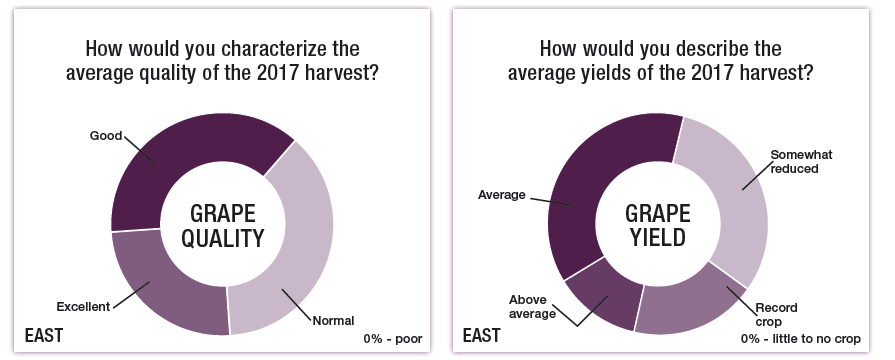
Ontario: Niagara, Prince Edward County and Lake Erie North Shore
Kevin Ker, Ph.D.
Research associate
CCOVI-Brock University
Overall it was a challenging year, though ultimately crop quality was excellent and yields were up from 2016. There had been concern for late-season reds due to cool early season conditions, but a good fall period allowed for them to properly mature by harvest. Some reds were harvested after November frost, but Brix, TA and pH came through with flying colors. Pinot Noir had challenges with sour rot in some vineyards, but harvest in these blocks still proved to be of good quality and quantity. For most of Ontario it was a good year, after lots of hard in-season work by growers to battle frequent early season rain and a prolonged ripening period.
The 2017 season in Ontario was cooler and wetter than most years. Niagara and Prince Edward County had normal growing degree-days, while Lake Erie North Shore was slightly above average. Cool, wet conditions started the season and extended to bloom. Bloom to véraison had normal growing conditions. From véraison to harvest was excellent, with warm temperatures and moderate to low precipitation. Some fruit was slow to mature, as high temperatures in early September seemed to shock vines, but they quickly recovered. Good conditions through October allowed red vinifera to mature well, with some harvests taking place just after hard frost in early November.
It was a high-pressure year for diseases: frequent rainfall, overcast skies and moderate temperatures. Downy mildew was more apparent in 2017, and powdery mildew was well controlled with fungicides. Dry conditions post-véraison kept botrytis in check, however sour rot was found in early thin-skin cultivars such as Pinot Noir. Symptoms for leafroll and red blotch virus were more evident as growing conditions favored virus expression (cool season/slower cluster maturation). Multicolored Asian lady beetles were very active but well controlled. Some mealybugs were observed in non-treated vineyards. Brown marmorated stinkbugs were monitored and found in traps but not in vineyards. Spotted wing drosophila was monitored.
Yields for most varieties were very good as conditions through bloom and Stage 2 were great for berry development. Prices were relatively stable from 2016.
Growers made more use of mechanized harvesters and optical sorters on harvesters to ensure premium fruit quality, remove poor fruit and decrease potential MOG for delivery to processors.
We continued to deal with new pests (spotted wing drosophila and brown marmorated stinkbugs) being found but as yet not a problem in vineyards. Sour rot and multicolored Asian lady beetles made it a late-season challenge to keep the crop clean. Getting the crop off and processed in timely fashion as yields continue to rise was an ongoing challenge for processors and growers.
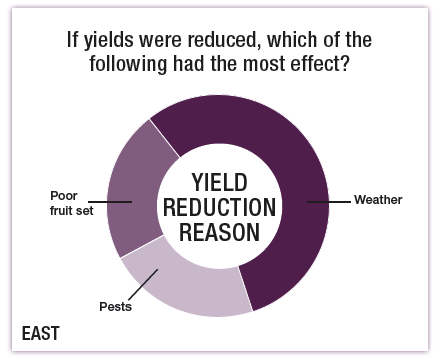
Pennsylvania
Linda Jones McKee
Wine East editor
Wines & Vines
The outlook for Pennsylvanians’ harvest improved when warm, sunny weather arrived in September and continued into October. Michela Centinari, assistant professor of viticulture at Penn State, reported that most growers were happy with the quality of the grapes. She noted that 2017 was a challenging season, but most growers were fine. The early white grapes were average in yield and quality, but warm weather in September increased quality of the later season red grapes. In the Lake Erie region, above-average temperatures during harvest resulted in the largest Concord crop on record. Overall quality for wine grapes and Concords was excellent.
Much of Pennsylvania had a cool, wet summer, but after Labor Day, the sun came out, the rain that fell every three or four days ceased, and vineyards dried out. In September, temperatures rose into the 80s and even the 90s during the day and dropped into the 60s (or lower) during the night.
The Lake Erie region as the exception to this statewide trend. According to Bryan Hed, research technologist at the Lake Erie Grape Research and Extension Center in North East, Pa., May and June were mostly dry, and July was “dry as a bone.” Rain in mid-August lowered the higher than normal temperatures, and the region was warm and dry in September and October.
Despite a challenging, wet summer, most growers kept the various grape diseases to a minimum by managing their canopies and applying sprays appropriately. Some growers reported downy mildew pressure as a result of the wet conditions. Centinari said the biggest problem was the spread of the spotted lanternfly, which was a major issue for the first time in at least eight vineyards in southeastern Pennsylvania by the end of the season. There is increasing concern that the insects are spreading to Delaware and New York. To date, there is no spray specifically for the spotted lanternfly. Spotted wing drosophila, hornets and wasps were also numerous. Labor is a problem for everyone across Pennsylvania.
Virginia
Tremain Hatch
Extension associate
Virginia Tech
For the most part, Virginia grapegrowers were happy with the 2017 season. Clear weather during the majority of harvest and full crops on most varieties made for excellent quality and quantity for the 2017 vintage.
Growers remarked that vines were running up to two weeks ahead of schedule for most of the season. Some sites experienced frost injury in early May. Central Virginia was dry from mid-summer on, while Northern Virginia received more rainfall in August. Temperatures were cooler than normal for a spell in late August, and then temperatures rebounded in mid-September. Most of the state experienced clear, dry and warm temperatures from mid-September to
mid-October.
Humid conditions in August caught a couple growers off guard with downy mildew.
Grape yields were up. Sometimes growers struggle with low yields with Viognier, but Viognier yields were generally good. Harvest is always hectic in nature. Consistent and dry conditions made harvest in Virginia smoother than most years.
|
|
PRINTER-FRIENDLY VERSION » |
|
|
E-MAIL THIS ARTICLE » |